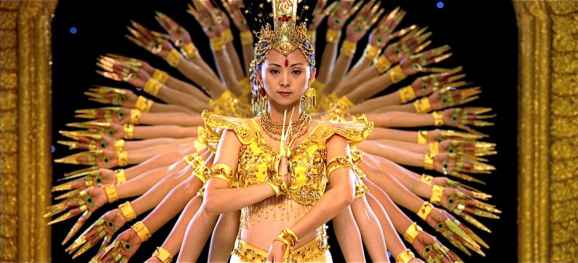Samsara Review: pictures; pretty and not-so-pretty ones
Documentaries can be challenging for movie goers. The very best are characterized by an ability to open a wider world and enlighten the viewer, bringing insight and understanding to the subject. Samsara, the 2011 film by David Fricke, is a completely different beast. Following up Fricke’s 1992 film Baraka, Samsara is a non-narrative documentary that explores the world and some of the people that make up the human race. Samsara was shot over five years in 25 countries with a crew of less than ten people.

To call Samsara a challenging film is at best an understatement and at worst an oversimplification. The film moves from place to place and image to image, showing scenes from all over the globe. Unfortunately, the film gives very little clue as to the context or the origin of the images. Some of the places shown are familiar but others are very rare sights to most viewers and the predominantly visual nature of the film offers nothing but the images. Without context this ‘picture-only’ process can be very frustrating to sit through as the most rewarding and satisfying images often leave a gap and a desire for more information. Some of the images while beautiful are deeply disturbing and can on occasion, create a wall between the viewer and the film.
There are clear transitions from place to place SOME of the time but other transitions leave the viewer more puzzled than interested. It does not help that some of the transitions are very heavy handed, like going from the image of a man in Africa buried in a gun shaped coffin to the image of a gun being manufactured. While others leave the viewer grasping for a connection. Many of the images are of some of the most beautiful sights human eyes could ever see. The ancient stone city and water conduit system of Petra in Jordan or the temples in Bagan are every bit as stunning to see as simple images of a muscular (and frankly a little scary) tattooed man cradling and cooing at his infant child. Unfortunately, without context these and the other amazing images in Samsara blend into an almost meaningless montage of imagery that is more puzzling than enlightening. Clearly the intention of the film is to give the viewer an ‘experience’ similar to a guided dream rather than be a source of information. Some viewers will find this frustrating and hard to adapt to.

Samara was shot on 70mm film and even on DVD, the image quality is stunning. The video quality here is not merely nice it is reference quality (so good, that this is the disc that TV salesmen should use to demo TVs). The 70mm prints were scanned at 8k and mastered at 4k, leaving the image sharp and vibrant with beautifully saturated colors and deep, inky blacks. For those not familiar with the term ‘4k’, it means the screen resolution is roughly twice that of 1080p hi-def pictures. This results in an image so life-like and intense that a 3D quality is created without needing the stupid glasses or suffering the headaches that can accompany bad 3D. There are moments in the film where the depth of field is overpowering and the images seem to be almost on top of the viewer. The image quality is stunning and the music that accompanies it is a powerful part of the film. The composers were very specific with their use of instruments and vocals and consequently, the music is very much responsible for the mood and flow of the film. In scoring this movie, the musicians watched the completed footage and then wrote the music to match the cut which bring an emotional intensity that is hard to describe. The music adds so much to the film yet can stand on its own as very powerful pieces. The music from both Samsara as well as Baraka is available as a sound track..
While I cannot say that this was an entirely positive viewing experience, I can say it was certainly powerful and engaging. Images of stunning beauty and power, like the preserved body of two-year-old Rosalia Lombardo—the “Sleeping Beauty of the Capuchin Catacombs”, are shown in sharp contrast to very dark and disturbing ones like the inner workings of a poultry processing plant in China and the realities of a sex doll factory. This is as much visual information about the Earth and the people that live on it as can be artfully put into a 102 minute film but it is not an easy film to watch. The picture quality of the DVD was a nice but if you can find Samsara on Blu-ray or stream it in HD you really should do so as the image quality is much better. While this style of film isn’t going to please everyone completely, I defy anyone to walk away from this movie without experiencing the emotional and visual impact that will make you stop and think about the beauty and horrors of our planet.
Rating:
What do you think? Leave a comment.











Does the style of this arts movie have any similarities to the style in Koyaanisqatsi?:
http://www.imdb.com/title/tt0085809/
If you haven’t watched it, watch it.
Great movie.
It is like a visual meditation. I love a movie that leaves me feeling that I have experienced and connected with part of life. I loved every bit of Samsara…
Found this to be a really interesting piece, after watching Baraka many, many years ago. I thought the most moving sequences were not only the poultry plant, but all the ‘factory’ sort of imagery – the women assembling irons by the thousands stunning, both visually and on a human level.
“…Samsara is a non-narrative documentary that explores the world and some of the people that make up the human race.”
Personally, I find that there is narrative in everything. In this case it simply seems to me that the narrative is that the filmmaker is showing a representation of humanity. What represents humanity is edited by means of what is included and (crucially) what is not included. The narrative here are the contents of the documentary.